
| Design to Rock By Rock and Roll Annex opens in New York City
Summary: New York City-based Montroy, Anderson, DeMarco designed the new 25,000-square-foot Rock and Roll Annex, the first outpost of the famed Cleveland Rock and Roll Hall of Fame. The Annex opened last November, houses artifacts from Cleveland, and traces the history of the music genre in New York City. The Annex is located in the SoHo section of the city and follows an “industrial grunge” theme in the cellar of an 80-year-old cast-iron building. There are aspirations by the nonprofit Rock and Roll Hall of Fame to brand itself worldwide in additional cities; however, the Annex and additional outposts will be profit ventures. The client for the project is Running Subway, a production company.
What about Rock and Roll Annexes in cities worldwide? Montroy and DeMarco are on board. Says Montroy: “We would like to have permission to do them all over the place.” It’s only rock and roll, but the architects like it. |
||
Copyright 2009 The American Institute of Architects. All rights reserved. Home Page |
||
news headlines
practice
business
design
recent related
› When You Walk by, this Museum Springs (and Sings) to Life
› UC San Diego’s New Music Center Design Combines Acoustic Performance with Striking Visuals
› Brick by Brick, Door by Door, Beam by Beam, the Wing Luke Asian Museum Retells the Stories of Seattle’s Asian Immigrants
Do You Know the Architect’s Knowledge Resource?
The AIA’s resource knowledge base can connect you to the PDF article Developing Winning Proposals: A Resume Preparation Checklist
See what else the Architect’s Knowledge Resource has to offer for your practice.
From the AIA Bookstore:
Building Type Basics for Performing Arts Facilities by Hugh Hardy, FAIA. (John Wiley and Sons, 2006).
Photos
Photos © Paul Warchol.
1. The Annex is located in the SoHo section of the city and follows an “industrial grunge” theme in the cellar of an 80-year-old cast-iron building.
2. A wall lights up the names of Rock and Roll Hall of Fame inductees.
3. The exhibit includes artifacts such as guitars, song notebooks, and the piano that John Lennon used to record his final album.
4. Visitors to the Annex follow a sequence upon entering: they begin in a hi-tech holding entrance area of state-of-the art audio and visual components. Original columns have been restored.
5. A multimedia theater-in-the-round shows projections of various artists.
6. An interactive 30-foot-long model of Manhattan has touch screens that light up iconic buildings of New York rock and roll.
7. Shown here at the Annex gala opening from left to right: Richard DeMarco, AIA; Steven Andersen; and Dan Montroy, AIA.

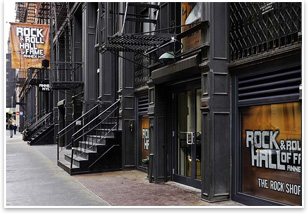 How do you . . .
How do you . . . 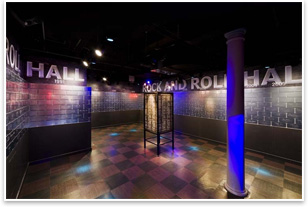 Rock on
Rock on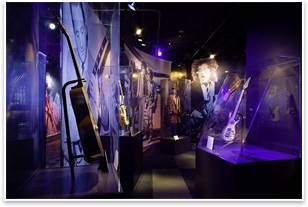 Partner Daniel Montroy, AIA, says the firm also intended the Annex be a functional space that serves as a backdrop to the rock and roll exhibitions. “We put in a black box ceiling and stripped it back to the raw structure to expose the mechanicals; we mounted lights and exposed elements of the original building, such as brick walls. We wanted to make the space raw, but beautiful and finished—a first-class tourist Mecca.” The industrial columns in the space were also restored.
Partner Daniel Montroy, AIA, says the firm also intended the Annex be a functional space that serves as a backdrop to the rock and roll exhibitions. “We put in a black box ceiling and stripped it back to the raw structure to expose the mechanicals; we mounted lights and exposed elements of the original building, such as brick walls. We wanted to make the space raw, but beautiful and finished—a first-class tourist Mecca.” The industrial columns in the space were also restored.
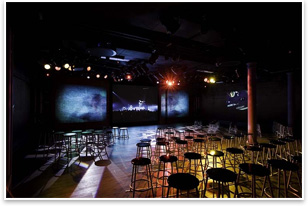 The flat-screen projections, rock and roll artifacts, and lighting are underscored with hi-tech audio. “Visitors wear headsets tuned to proximity sensors beneath the carpet that allow them to hear music and discussions in any quadrant they are viewing,” says Richard DeMarco, AIA, partner. Circulation coils through a tight space without feeling tight. The entrance and exit are close to each other so as not to run from one extreme corner of the facility to the other. The Annex can hold up to 750 people at any given moment and process 100 people every 15-20 minutes.
The flat-screen projections, rock and roll artifacts, and lighting are underscored with hi-tech audio. “Visitors wear headsets tuned to proximity sensors beneath the carpet that allow them to hear music and discussions in any quadrant they are viewing,” says Richard DeMarco, AIA, partner. Circulation coils through a tight space without feeling tight. The entrance and exit are close to each other so as not to run from one extreme corner of the facility to the other. The Annex can hold up to 750 people at any given moment and process 100 people every 15-20 minutes.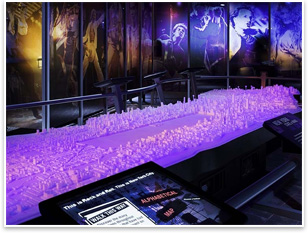 Facilities upgrade; the big model of Manhattan
Facilities upgrade; the big model of Manhattan A rockin’ feature of the Annex is an interactive, 30-foot-long model of Manhattan. Visitors touch screens that light up iconic buildings of New York rock and roll history. “It’s awe-inspiring,” Montroy enthuses.
A rockin’ feature of the Annex is an interactive, 30-foot-long model of Manhattan. Visitors touch screens that light up iconic buildings of New York rock and roll history. “It’s awe-inspiring,” Montroy enthuses.